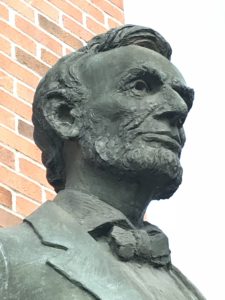 On April 11, 1865, President Abraham Lincoln gave his last speech to the public. In it he called for voting rights for African Americans, both those already free and those freed from slavery. It wasn’t the first time he called for expansion of voting rights.
On April 11, 1865, President Abraham Lincoln gave his last speech to the public. In it he called for voting rights for African Americans, both those already free and those freed from slavery. It wasn’t the first time he called for expansion of voting rights.
The speech was occasioned because a few days before Confederate General Robert E. Lee surrendered to Union General Ulysses S. Grant at Appomattox Courthouse. Lincoln had just missed being there himself, having returned that day to Washington, where Secretary of State William Seward was recovering from a carriage accident. On April 10th, crowds gathered outside the White House asking for a speech. Lincoln demurred, saying that such a speech should be thoughtful and prepared, not extemporaneous. Instead he called for the band to play Dixie, a song that he believed the surrender demonstrated “we fairly captured.” The next night he again came to the White House window and read a carefully worded speech, silently dropping the pages behind him as he read to be picked up by his son Tad. Mostly he spoke about reconstruction and the “gladness of heart” that the long ordeal of Civil War was coming to a close. But he also made a rather radical call for voting rights for African Americans. Loyal citizens of Louisiana had passed a new constitution but was missing one aspect Lincoln felt important.
The amount of constituency, so to speak, on which the new Louisiana government rests, would be more satisfactory to all, if it contained fifty, thirty, or even twenty thousand, instead of only about twelve thousand, as it does. It is also unsatisfactory to some that the elective franchise is not given to the colored man. I would myself prefer that it were now conferred on the very intelligent, and on those who serve our cause as soldiers.
Through letters and telegrams, Lincoln had privately been encouraging Louisiana to give voting rights to the free and newly freed black population, which made up more than half of the total population. He was unsuccessful in convincing them but felt that bringing Louisiana back into the Union was a step in that direction. Of course, the 15th Amendment would shortly ensure that “The right of citizens of the United States to vote shall not be denied or abridged by the United States or by any State on account of race, color, or previous condition of servitude.”
But this wasn’t the first time Lincoln encouraged the expansion of voting rights. He also worked to ensure that soldiers had a means to vote during the war. Republicans had lost several congressional seats in the fall 1862 elections, in part due to pushback after Lincoln’s issuance of the Preliminary Emancipation Proclamation, but also because there were a disproportionate number of Republican voters in the field as soldiers volunteering to preserve the Union. At that point most states still required soldiers and sailors to return to their homes to vote in elections, a practical impossibility during wartime. Several, but not all, states made changes to allow field voting for the military. To ensure soldiers were able to vote in the 1864 election, Lincoln worked with field commanders to allow leave for those soldiers living in intransigent states to return home to cast their ballots. The election of 1864 is also special in the fact that it occurred at all. Many suggested to Lincoln that he postpone the election because of the war. Lincoln refused, insisting that elections were necessary for the continuation of the Union. He noted:
If the rebellion could force us to forego or postpone a national election, it might fairly claim to have been already conquered and ruined us.
But yet again, this wasn’t the first time Lincoln encouraged the expansion of voting rights. On June 13, 1836 he announced his candidacy for reelection to a second term of the Illinois legislature (he would go on to serve four terms). At this early date, when blacks and women effectively had second-class citizenship, he said:
I go for all sharing the privileges of the government, who assist in bearing its burthens. Consequently I go for admitting all whites to the right of suffrage, who pay taxes or bear arms, (by no means excluding females.)
While the 15th amendment ensured the right to vote for black men in 1870, women were, contrary to Lincoln’s wishes, excluded until the 19th Amendment was ratified in 1920. [This year is the 100th anniversary of that event]
Abraham Lincoln could be considered today as a prudent progressive, moving progress forward by increments, but steadily. And yet, he moved public sentiment such that we as a nation came to accept emancipation and, eventually, the concept that “all men are created equal” (by no means excluding females, minorities, elderly, disabled, veterans, LGBTQ, Jews, Muslims, Buddhists, and everyone else). Lincoln didn’t live to see all of these battles won, but he did take what would be considered bold steps for a mid-19th century politician. On this date, April 11, 1865, he stood up for the rights of people once held as slaves to vote.
“It is for us the living,” Lincoln said in his Gettysburg Address, “to be dedicated here to the unfinished work which they who fought here so nobly advanced.” We must “here highly resolve” to ensure voting rights to all Americans even in this current time of turmoil.
David J. Kent is an avid science traveler and the author of Lincoln: The Man Who Saved America, in Barnes and Noble stores now. His previous books include Tesla: The Wizard of Electricity and Edison: The Inventor of the Modern World and two specialty e-books: Nikola Tesla: Renewable Energy Ahead of Its Time and Abraham Lincoln and Nikola Tesla: Connected by Fate.
Check out my Goodreads author page. While you’re at it, “Like” my Facebook author page for more updates!



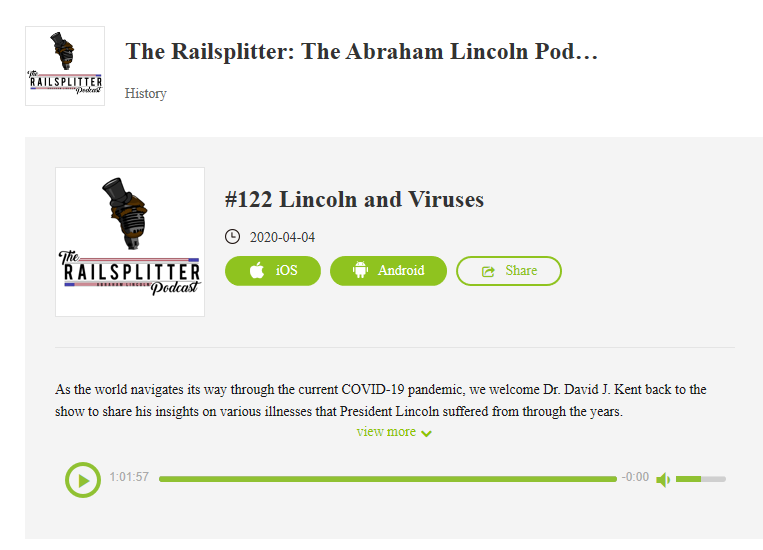
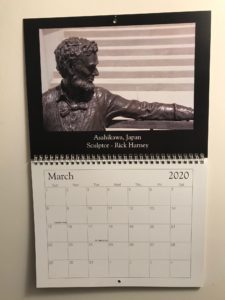 Travel has been curtailed for the near future due to coronavirus, so I remember my trip to Japan as I look at the March calendar photo from David Wiegers. You can click on these links to see the entries for January (
Travel has been curtailed for the near future due to coronavirus, so I remember my trip to Japan as I look at the March calendar photo from David Wiegers. You can click on these links to see the entries for January (

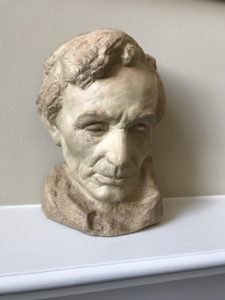 Well, the worldwide coronavirus outbreak has certainly caused a lot of disruption lately. Like everyone else, I’m social distancing (even more than usual), which means tons of cancellations of upcoming appearances and presentations.
Well, the worldwide coronavirus outbreak has certainly caused a lot of disruption lately. Like everyone else, I’m social distancing (even more than usual), which means tons of cancellations of upcoming appearances and presentations.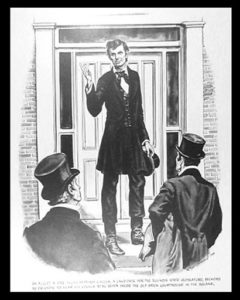 During Abraham Lincoln’s first year in New Salem he joined a pretentiously named Literary and Debating Society, which was actually an informal discussion group run by James Rutledge. Rutledge was a well-respected leader in town, father of ten children, and proprietor of an inn, Rutledge’s Tavern. He also had an extensive personal library of nearly thirty books, and this became one of Lincoln’s favorite hangouts.
During Abraham Lincoln’s first year in New Salem he joined a pretentiously named Literary and Debating Society, which was actually an informal discussion group run by James Rutledge. Rutledge was a well-respected leader in town, father of ten children, and proprietor of an inn, Rutledge’s Tavern. He also had an extensive personal library of nearly thirty books, and this became one of Lincoln’s favorite hangouts.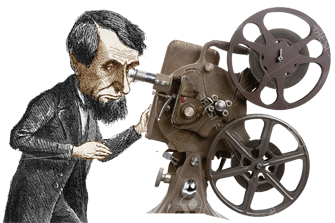
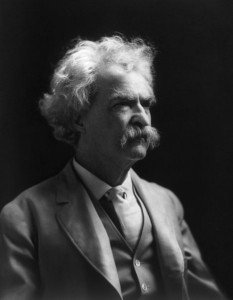 Samuel Clemens, known to most of us by his pseudonym Mark Twain, was born in Hannibal, Missouri on November 30, 1835, shortly after Halley’s Comet had made its regular but rare pass by the Earth. The 26-year-old Abraham Lincoln – an amateur astronomy buff who two years earlier had marveled at the Leonid meteor showers – may very well have been gazing at the skies when Mark Twain came into this world. At that age Lincoln lived in New Salem, Illinois, just a stone’s throw across the Mississippi River from Hannibal. In 1859, Lincoln rode the Hannibal and St. Joseph Railroad to give a speech in Council Bluffs, Iowa. The railroad just happened to be formed in the office of Mark Twain’s father thirteen years before.
Samuel Clemens, known to most of us by his pseudonym Mark Twain, was born in Hannibal, Missouri on November 30, 1835, shortly after Halley’s Comet had made its regular but rare pass by the Earth. The 26-year-old Abraham Lincoln – an amateur astronomy buff who two years earlier had marveled at the Leonid meteor showers – may very well have been gazing at the skies when Mark Twain came into this world. At that age Lincoln lived in New Salem, Illinois, just a stone’s throw across the Mississippi River from Hannibal. In 1859, Lincoln rode the Hannibal and St. Joseph Railroad to give a speech in Council Bluffs, Iowa. The railroad just happened to be formed in the office of Mark Twain’s father thirteen years before.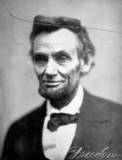 Lincoln floated flatboats down the Mississippi River to New Orleans as a young adult, then took steamboats back upriver. He often piloted steamboats around shoals near his New Salem home. Mark Twain had worked on steamboats on the river for much of his younger years, first as a deckhand and then as a pilot. Being a riverboat pilot gave him his pen name; “mark twain” is “the leadsman’s cry for a measured river depth of two fathoms (12 feet), which was safe water for a steamboat.” In 1883 Twain even titled his memoir, Life on the Mississippi. As we have already seen, Lincoln’s time traveling on and piloting steamboats eventually inspired his patent for lifting boats over shoals and obstructions on the river.
Lincoln floated flatboats down the Mississippi River to New Orleans as a young adult, then took steamboats back upriver. He often piloted steamboats around shoals near his New Salem home. Mark Twain had worked on steamboats on the river for much of his younger years, first as a deckhand and then as a pilot. Being a riverboat pilot gave him his pen name; “mark twain” is “the leadsman’s cry for a measured river depth of two fathoms (12 feet), which was safe water for a steamboat.” In 1883 Twain even titled his memoir, Life on the Mississippi. As we have already seen, Lincoln’s time traveling on and piloting steamboats eventually inspired his patent for lifting boats over shoals and obstructions on the river.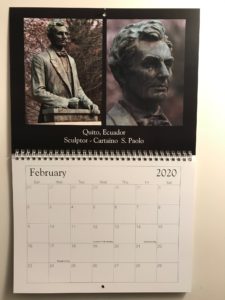 As Lincoln’s birthday week begins I turn to the David Wiegers calendar for another international statue of Abraham Lincoln. This one is in Quito, Ecuador.
As Lincoln’s birthday week begins I turn to the David Wiegers calendar for another international statue of Abraham Lincoln. This one is in Quito, Ecuador.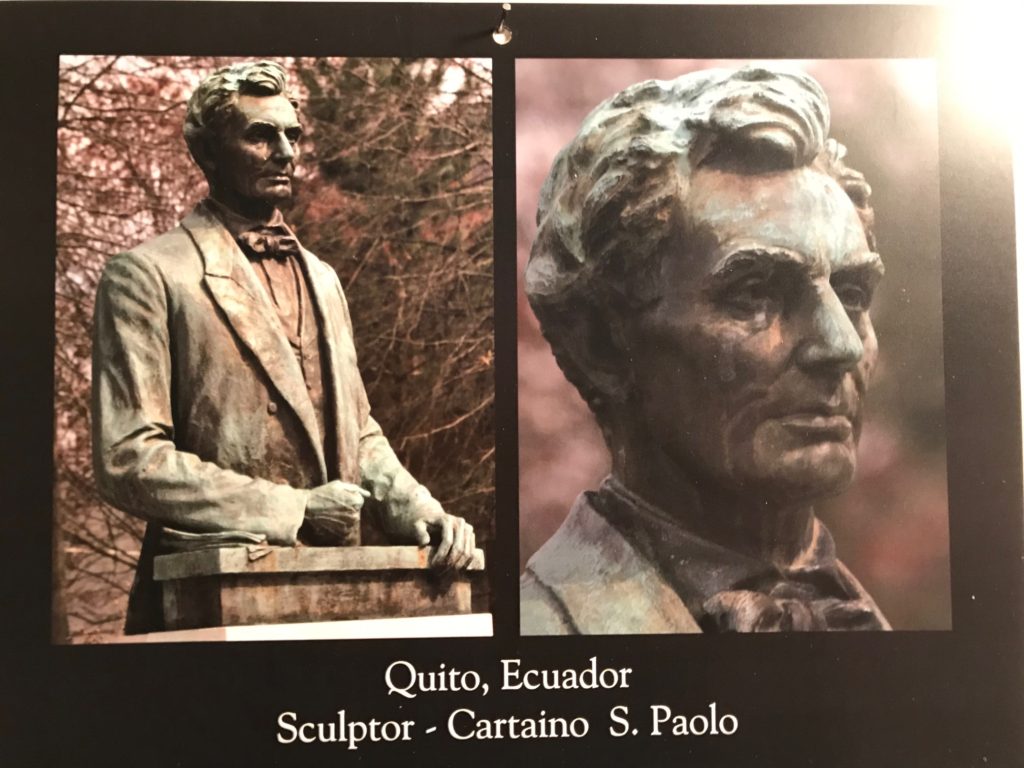
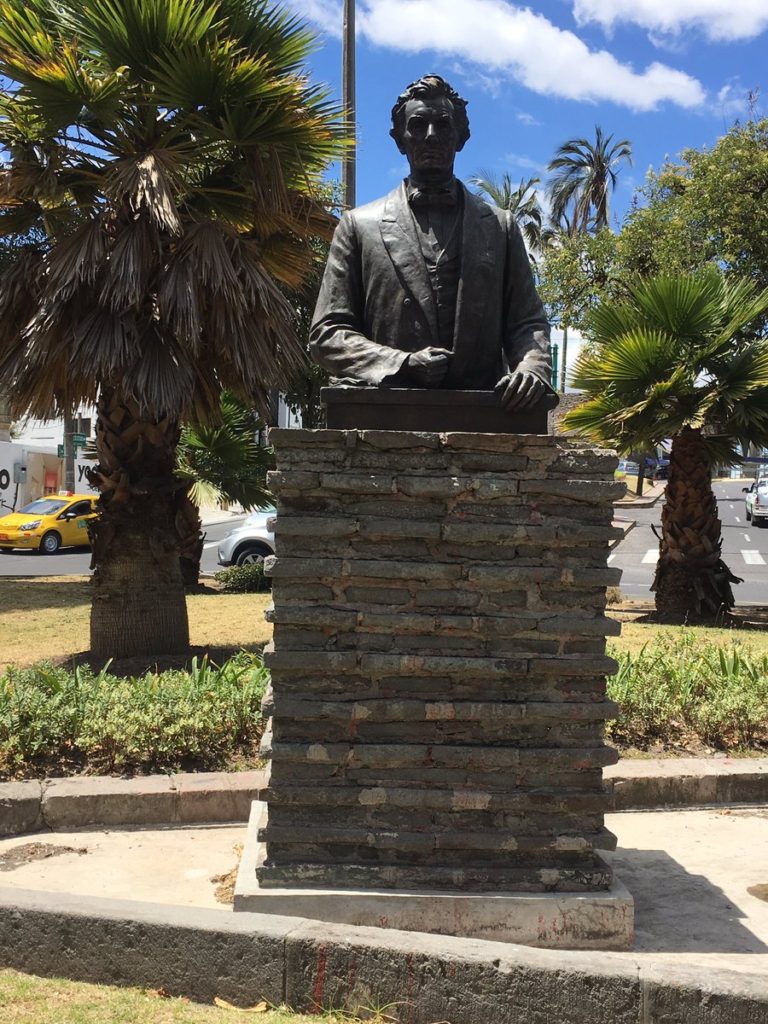
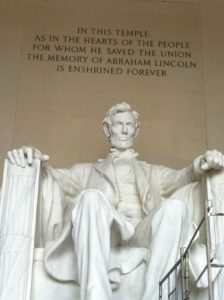 Abraham Lincoln is best known for his Emancipation Proclamation, Gettysburg Address, and saving the Union during the Civil War. But in this Black History Month it’s important to remember that Lincoln also pushed for black voting rights.
Abraham Lincoln is best known for his Emancipation Proclamation, Gettysburg Address, and saving the Union during the Civil War. But in this Black History Month it’s important to remember that Lincoln also pushed for black voting rights.






